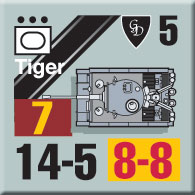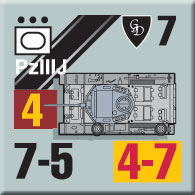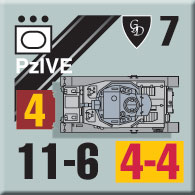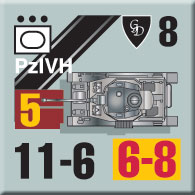| Burning Tigers:
Grossdeutschland 1943
By Mike Bennighof, Ph.D.
September 2022
In the spring of 1943, the elite German motorized infantry division “Grossdeutschland” pulled out of the front line for re-organization and re-equipment. As a highly favored unit, it received such treatment far more often than the usual German Army formation. But with a massive new offensive in the offing, this time the re-fitting had a very definite purpose.
 Though now titled “Panzer Grenadier Division Grossdeutschland,” the re-organized division would be much stronger than a standard panzer grenadier division or even panzer division. Like a panzer grenadier division, it had two regiments each of three battalions. In early June 1943, about a month before the Battle of Kursk opened, the division received enough half-track armored personnel carriers to mount the first battalion of each of its motorized infantry regiments – a practice usually confined to well-equipped panzer divisions. Though now titled “Panzer Grenadier Division Grossdeutschland,” the re-organized division would be much stronger than a standard panzer grenadier division or even panzer division. Like a panzer grenadier division, it had two regiments each of three battalions. In early June 1943, about a month before the Battle of Kursk opened, the division received enough half-track armored personnel carriers to mount the first battalion of each of its motorized infantry regiments – a practice usually confined to well-equipped panzer divisions.
 That doesn’t tell the whole story: each battalion, at least on paper, had considerably more firepower than the panzer grenadier battalions of regular panzer and panzer grenadier divisions. Each had the typical three rifle companies and one machine gun company, but had three machine gun platoons rather than two, and a fifth “heavy” company with an additional engineer platoon and infantry gun platoon. In the normal line unit, the mortar and machine gun elements had been broken up and assigned to the rifle companies. A Grossdeutschland rifle company copied this organization and thus had its own machine gun and mortar support – the battalion-level assets were in addition to these, giving the Grossdeutschland battalion twice as many machine guns and mortars. That doesn’t tell the whole story: each battalion, at least on paper, had considerably more firepower than the panzer grenadier battalions of regular panzer and panzer grenadier divisions. Each had the typical three rifle companies and one machine gun company, but had three machine gun platoons rather than two, and a fifth “heavy” company with an additional engineer platoon and infantry gun platoon. In the normal line unit, the mortar and machine gun elements had been broken up and assigned to the rifle companies. A Grossdeutschland rifle company copied this organization and thus had its own machine gun and mortar support – the battalion-level assets were in addition to these, giving the Grossdeutschland battalion twice as many machine guns and mortars.
 And that was just the start. A panzer grenadier division usually had either a tank battalion or one of assault guns. Grossdeutschland had one of each, and in the spring of 1943 received a second tank battalion. As if that were not enough, an oversized company of Tiger tanks joined the division as well, expanding to become the tank regiment’s third battalion in the August 1943. A regular panzer division had but two tank battalions, and no assault guns (unless they took the place of tanks). And that was just the start. A panzer grenadier division usually had either a tank battalion or one of assault guns. Grossdeutschland had one of each, and in the spring of 1943 received a second tank battalion. As if that were not enough, an oversized company of Tiger tanks joined the division as well, expanding to become the tank regiment’s third battalion in the August 1943. A regular panzer division had but two tank battalions, and no assault guns (unless they took the place of tanks).
 And there was still more extra firepower. They typical German panzer division’s artillery regiment had three battalions, two of them of towed guns and one self-propelled. Grossdeutschland had a fourth artillery battalion. The regular army panzer division had an anti-aircraft battalion with three batteries (two of 88mm guns, one of light guns); Grossdeutschland’s battalion had six batteries (three each, heavy and light). And there was still more extra firepower. They typical German panzer division’s artillery regiment had three battalions, two of them of towed guns and one self-propelled. Grossdeutschland had a fourth artillery battalion. The regular army panzer division had an anti-aircraft battalion with three batteries (two of 88mm guns, one of light guns); Grossdeutschland’s battalion had six batteries (three each, heavy and light).
 All told, Grossdeutschland’s combat strength probably equaled that of a regular Army panzer division plus a regular Army panzer grenadier division. That sort of weaponry certainly helped Grossdeutschland gain a reputation as an elite unit; Grossdeutschland’s morale and tactical leadership appear to have been very good, but there’s no substitute for firepower. All told, Grossdeutschland’s combat strength probably equaled that of a regular Army panzer division plus a regular Army panzer grenadier division. That sort of weaponry certainly helped Grossdeutschland gain a reputation as an elite unit; Grossdeutschland’s morale and tactical leadership appear to have been very good, but there’s no substitute for firepower.
 At Kursk, Grossdeutschland was deployed with 48th Panzer Corps as part of the southern German flank. It suffered heavy casualties in the initial assault, particularly in its Fusilier regiment which became entangled in thick Soviet minefields. The tank regiment, deploying its Tigers at the tip of a giant armored wedge, managed to make some progress but despite all that firepower Grossdeutschland did not do as well as the neighboring 3rd Panzer Division. The division was not involved in the massive tank battle at Prokhorovka. At Kursk, Grossdeutschland was deployed with 48th Panzer Corps as part of the southern German flank. It suffered heavy casualties in the initial assault, particularly in its Fusilier regiment which became entangled in thick Soviet minefields. The tank regiment, deploying its Tigers at the tip of a giant armored wedge, managed to make some progress but despite all that firepower Grossdeutschland did not do as well as the neighboring 3rd Panzer Division. The division was not involved in the massive tank battle at Prokhorovka.
 Panzer Grenadier Division Grossdeutschland appears in seven scenarios in Panzer Grenadier: Kursk, Burning Tigers. To make those even more fun – yes, they can be made even more fun – we have the Grossdeutschland 1943 special pieces set. It’s an exclusive download for our Gold Club, with 176 pieces showing Panzer Grenadier Division Grossdeutschland as it stood in the summer of 1943, in its own unique color scheme (which matches appearancess in our Grossdeutschland 1944 book, and in 1940: The Fall of France). Panzer Grenadier Division Grossdeutschland appears in seven scenarios in Panzer Grenadier: Kursk, Burning Tigers. To make those even more fun – yes, they can be made even more fun – we have the Grossdeutschland 1943 special pieces set. It’s an exclusive download for our Gold Club, with 176 pieces showing Panzer Grenadier Division Grossdeutschland as it stood in the summer of 1943, in its own unique color scheme (which matches appearancess in our Grossdeutschland 1944 book, and in 1940: The Fall of France).
You don’t need these pieces to play those seven scenarios: the scenarios play the way they should using the standard German Army pieces from the game. But of course, you’ll want to use them anyway.
You can order Burning Tigers (Playbook edition) right here.
Click here to join the Gold Club.
See your Gold Club Insider newsletter for ordering information.
Sign up for our newsletter right here. Your info will never be sold or transferred; we'll just use it to update you on new games and new offers.
Mike Bennighof is president of Avalanche Press and holds a doctorate in history from Emory University. A Fulbright Scholar and NASA Journalist in Space finalist, he has published a great many books, games and articles on historical subjects; people are saying that some of them are actually good.
He lives in Birmingham, Alabama with his wife, three children, and new puppy. He misses his lizard-hunting Iron Dog, Leopold.
Want to keep Daily Content free of third-party ads? You can send us some love (and cash) through this link right here.
|
